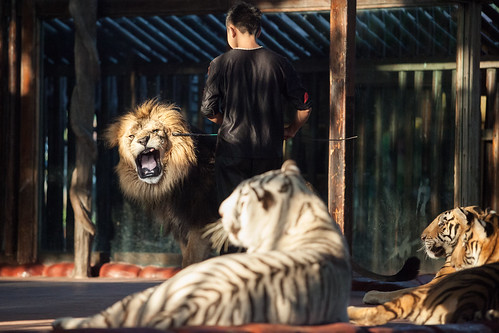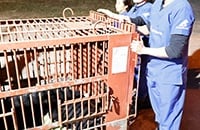This animal’s got talent – but it’s not for entertaining
15 May 2015

By Dave Neale, Animals Asia's Animal Welfare Director
The curtains open and the spotlight hits the “star” – a star that should never have been there.
His talents are best used in the natural environment – climbing, foraging, and playing among jungle cover. Human intervention has meant instead he has been taught a whole new set of skills. Skills that he has been forced to acquire through cruelty. Skills that are of no natural use to him.
This is an international phenomenon. It’s quite remarkable that people are willing to pay money to see an animal perform out of fear. It’s even more remarkable that it is still allowed to happen.
In China there has been a growing controversy recently over the use of captive “wild” animals, including baby chimpanzees and orang-utans, elephants and tigers in TV shows.
Such shows often see celebrities kissing, cuddling and in many situations forcing the animals into performing a range of behaviours that are supposed to be cute but certainly aren’t natural. All for entertainment.

In some cases this has led to the animals becoming frustrated – and in one incident, a baby chimpanzee bit one of the stars.
The use of animals for entertainment on television even resulted in an orang-utan, a bear, a hippo, an elephant and a giraffe all crammed into a TV studio for CCTV’s 2014 New Year Gala – a situation where the animal welfare needs cannot possibly have been upheld.
Sadly, the situation is similar elsewhere in the world as a number of international TV programmes and movies have pushed wild animals into unnatural situations.
Sadly, such absurdities are not limited to any specific region.
Movies such as “Pirates of the Caribbean”, “The Hangover” and “Night at the Museum” have all used capuchin monkeys dressed in clothes to play a “comic” role, while secret footage revealed the star elephant in 2011 Hollywood blockbuster “Water for Elephants” was being hit off-screen with a metal “bullhook” and given electric shocks via a hand-held stun gun. No doubt to ensure that it behaved when on the set.
Captive wild animals neither ask nor wish to be the stars of our on-screen fantasies. Exploiting them for TV shows, movies and close contact opportunities may seem fun to some - but causes unnecessary stress and suffering to innocent animals.
Many such animals are removed from their mothers at an inappropriate age so that they can be hand reared, and held in social isolation, making it easier for the trainers to access them and attempt to habituate them to human contact. Juvenile primates have an extended development period, during this time they need the companionship of older animals to allow their behaviour to develop normally. Artificial rearing disrupts this natural process and often results in socially maladjusted animals who lack the skills for normal behaviour. Research has demonstrated that animals separated from their mothers at an early age, or raised in an inappropriately unstimulating environment, are much more likely to develop behavioural problems and stereotypy as they age.
The people responsible for the care of animals used in TV shows, movies and for other close contact sessions often have little training in meeting their complex physical and psychological needs, and the training techniques adopted to force animals to behave during such sessions are often abusive. Many trainers use some degree of negative reinforcement, training the animal by punishing it when it doesn't do what they want.
Members of the public, and as in the aforementioned cases, TV celebrities, often have little idea of how to safely handle captive wild animals or the dangers they expose themselves to by being in such close proximity. Incidents of people being seriously harmed, and in some cases killed, during close contact sessions are documented internationally. In China, a six-year-old girl was reportedly killed by a tiger during a close contact session at Kunming Zoo in 2007.
By promoting close contact between people and captive wild animals, TV programmes do very little to promote respect and empathy for animals or to educate people on the nature of wild animals and the need for us to protect and care for them and their wild counterparts.
In fact all they seem to achieve is to simply encourage the public to replicate a reality TV star or film character’s behaviour. This is likely to promote close contact activities with captive wild animals at zoos and safari parks, and encourage the desire for people to have such “exotic” animals as companion animals. This can only lead to further suffering, seeing these animals at the mercy of people with little idea of how to meet their complex needs.
Animals do not wish to be the stars of our on-screen games. Please respect them for what they are and do not use and abuse them for entertainment.
Thanks to Britta Jaschinski for the kind use of two of her award winning photographs - at the top of this post. See more of Britta's work on her website.
BACK







 5 reasons the dog meat trade must end
5 reasons the dog meat trade must end
 New year, new home for Christmas the Bear!
New year, new home for Christmas the Bear!
 Veterinary welfare training – pain management
Veterinary welfare training – pain management